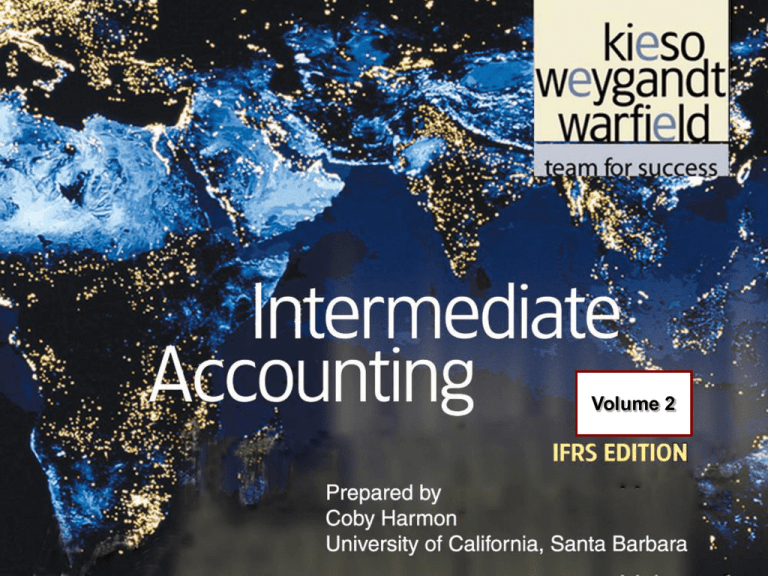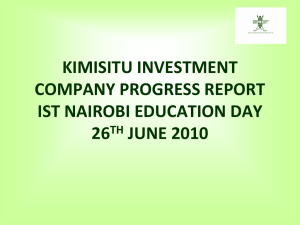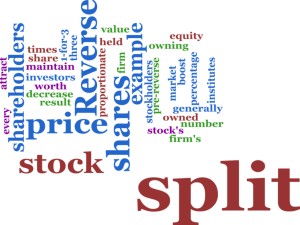
Volume 2
15-1
CHAPTER
15
EQUITY
Intermediate Accounting
IFRS Edition
Kieso, Weygandt, and Warfield
15-2
Learning Objectives
1.
Discuss the characteristics of the corporate form of organization.
2.
Identify the key components of equity.
3.
Explain the accounting procedures for issuing shares.
4.
Describe the accounting for treasury shares.
5.
Explain the accounting for and reporting of preference shares.
6.
Describe the policies used in distributing dividends.
7.
Identify the various forms of dividend distributions.
8.
Explain the accounting for small and large share dividends, and for
share splits.
9.
Indicate how to present and analyze equity.
15-3
Equity
The Corporate
Form
Corporate law
Share system
Variety of
ownership
interests
Equity
Issuance of
shares
Reacquisition
of shares
Preference
Shares
Features
Accounting
for and
reporting
preference
shares
Dividend
Policy
Financial
condition and
dividend
distributions
Types of
dividends
Shares split
Disclosure of
restrictions
15-4
Presentation
and Analysis
Presentation
Analysis
The Corporate Form of Organization
Three primary forms of business organization
Proprietorship
Partnership
Corporation
Special characteristics of the corporate form:
1. Influence of state corporate law.
2. Use of the share system.
3. Development of a variety of ownership interests.
15-5
LO 1 Discuss the characteristics of the corporate form of organization.
The Corporate Form of Organization
State Corporate Law
Corporation must submit articles of incorporation to the
appropriate governmental agency for the country in which
incorporation is desired.
General Motors - incorporated in Delaware.
U.S. Steel - incorporated in New Jersey.
Accounting for equity follows the provisions of the business
incorporation act of each government.
15-6
LO 1 Discuss the characteristics of the corporate form of organization.
The Corporate Form of Organization
Share System
In the absence of restrictive provisions, each share carries
the following rights:
1. To share proportionately in profits and losses.
2. To share proportionately in management (the right to vote
for directors).
3. To share proportionately in assets upon liquidation.
4. To share proportionately in any new issues of shares of
the same class—called the preemptive right.
15-7
LO 1 Discuss the characteristics of the corporate form of organization.
The Corporate Form of Organization
Variety of Ownership Interests
Ordinary shares represent the residual corporate interest.
Bears ultimate risks of loss.
Receives the benefits of success.
Not guaranteed dividends nor assets upon dissolution.
Preference shares are created by contract, when shareholders’
sacrifice certain rights in return for other rights or privileges, usually
dividend preference.
15-8
LO 1 Discuss the characteristics of the corporate form of organization.
Equity
Ordinary Shares
Contributed
Capital
Account
Share Premium
Account
Preference Shares
Account
Two Primary
Sources of
Equity
Retained Earnings
Account
Less:
Treasury Shares
Assets –
Liabilities =
Equity
Account
15-9
LO 2 Identify the key components of equity.
Equity
Issuance of Shares
Shares authorized - Shares sold - Shares issued
Accounting problems:
1. Par value shares.
2. No-par shares.
3. Shares issued in combination with other securities.
4. Shares issued in non-cash transactions.
5. Costs of issuing shares.
15-10
LO 3 Explain the accounting procedures for issuing shares.
Equity
Par Value Shares
Low par values help companies avoid a contingent liability.
Corporations maintain accounts for:
15-11
Preference Shares or Ordinary Shares.
Share Premium
LO 3 Explain the accounting procedures for issuing shares.
Equity
No-Par Shares
Reasons for issuance:
Avoids contingent liability.
Avoids confusion over recording par value versus
fair market value.
A major disadvantage of no-par shares is that some countries levy
a high tax on these issues. In addition, in some countries the total
issue price for no-par shares may be considered legal capital, which
could reduce the flexibility in paying dividends.
15-12
LO 3 Explain the accounting procedures for issuing shares.
Equity
Illustration: Video Electronics Corporation is organized with
10,000 ordinary shares authorized without par value. If Video
Electronics issues 500 shares for cash at €10 per share, it
makes the following entry.
Cash
5,000
Share Capital—Ordinary
15-13
5,000
LO 3 Explain the accounting procedures for issuing shares.
Equity
Illustration: Some countries require that no-par shares have a
stated value. If a company issued 1,000 of the shares with a €5
stated value at €15 per share for cash, it makes the following
entry.
Cash
15,000
Share Capital—Ordinary
Share Premium—Ordinary
15-14
5,000
10,000
LO 3 Explain the accounting procedures for issuing shares.
Equity
Shares Issued with Other Securities
Two methods of allocating proceeds:
15-15
Proportional method.
Incremental method.
LO 3 Explain the accounting procedures for issuing shares.
Equity
BE15-4: Ravonette Corporation issued 300 shares of $10 par value
ordinary shares and 100 shares of $50 par value preference shares for
a lump sum of $13,500. The ordinary shares have a market value of
$20 per share, and the preference shares have a market value of $90
per share.
Ordinary shares
Preference shares
Allocation:
Issue price
Allocation %
Total
15-16
Number
300
100
Ordinary
$ 13,500
40%
$
5,400
Amount
Total
x $
20.00 = $ 6,000
x
90.00
9,000
Fair Market Value $ 15,000
Preference
$
13,500
60%
$
8,100
Percent
40%
60%
100%
Proportional
Method
LO 3
Equity
BE15-4: Ravonette Corporation issued 300 shares of $10 par value
ordinary shares and 100 shares of $50 par value preference shares for
a lump sum of $13,500. The ordinary shares have a market value of
$20 per share, and the preference shares have a market value of $90
per share.
Journal entry (Proportional):
Cash
15-17
13,500
Preference shares (100 x $50)
5,000
Share premium - preference
3,100
Ordinary shares (300 x $10)
3,000
Share premium - ordinary
2,400
LO 3 Explain the accounting procedures for issuing shares.
Equity
BE15-4 (Variation): Ravonette Corporation issued 300 shares of $10
par value ordinary shares and 100 shares of $50 par value preference
shares for a lump sum of $13,500. The ordinary shares have a market
value of $20 per share, and the value of preference shares are unknown.
Ordinary shares
Preference shares
Allocation:
Issue price
Ordinary
Total
15-18
Number
300
100
Ordinary
$
6,000
Amount
Total
x $
20.00 = $ 6,000
x
Fair Market Value $ 6,000
Preference
$
13,500
(6,000)
$
7,500
Incremental
Method
LO 3 Explain the accounting procedures for issuing shares.
Equity
BE15-4 (Variation): Ravonette Corporation issued 300 shares of $10
par value ordinary shares and 100 shares of $50 par value preference
shares for a lump sum of $13,500. The ordinary shares have a market
value of $20 per share, and the value of preference shares are unknown.
Journal entry (Incremental):
Cash
15-19
13,500
Preference shares (100 x $50)
5,000
Share premium - preference
2,500
Ordinary shares (300 x $10)
3,000
Share premium - ordinary
3,000
LO 3 Explain the accounting procedures for issuing shares.
Equity
Shares Issued in Noncash Transactions
The general rule: Companies should record shares
issued for services or property other than cash at the
15-20
fair value of the goods or services received.
If the fair value of the goods or services cannot be
measured reliably, use the fair value of the shares
issued.
LO 3 Explain the accounting procedures for issuing shares.
Equity
Illustration: The following series of transactions illustrates
the procedure for recording the issuance of 10,000 shares of
$10 par value ordinary shares for a patent for Marlowe
Company, in various circumstances.
1. Marlowe cannot readily determine the fair value of the
patent, but it knows the fair value of the shares is $140,000.
Patent
140,000
Share Capital—Ordinary
Share Premium—Ordinary
15-21
100,000
40,000
LO 3 Explain the accounting procedures for issuing shares.
Equity
2. Marlowe cannot readily determine the fair value of the
shares, but it determines the fair value of the patent is
$150,000.
Patent
150,000
Share Capital—Ordinary
Share Premium—Ordinary
15-22
100,000
50,000
LO 3 Explain the accounting procedures for issuing shares.
Equity
3. Marlowe cannot readily determine the fair value of the
shares nor the fair value of the patent. An independent
consultant values the patent at $125,000 based on discounted
expected cash flows.
Patent
125,000
Share Capital—Ordinary
Share Premium—Ordinary
15-23
100,000
25,000
LO 3 Explain the accounting procedures for issuing shares.
Equity
Costs of Issuing Stock
Direct costs incurred to sell shares, such as
underwriting costs,
accounting and legal fees,
printing costs, and
taxes,
should reduce the proceeds received from the sale of the
shares.
15-24
LO 3 Explain the accounting procedures for issuing shares.
Equity
Reacquisition of Shares
Corporations purchase their outstanding shares to:
Provide tax-efficient distributions of excess cash to
shareholders.
Increase earnings per share and return on equity.
Provide shares for employee compensation contracts or to
meet potential merger needs.
15-25
Thwart takeover attempts or to reduce the number of
shareholders.
Make a market in the shares.
LO 4 Describe the accounting for treasury shares.
Equity
Purchase of Treasury Shares
Two acceptable methods:
Cost method (more widely used).
Par or Stated value method.
Treasury shares reduces equity.
15-26
LO 4 Describe the accounting for treasury shares.
Equity
Illustration: Pacific Company issued 100,000 shares of $1 par
value ordinary shares at a price of $10 per share. In addition, it
has retained earnings of $300,000.
Illustration 15-3
15-27
LO 4 Describe the accounting for treasury shares.
Equity
Illustration: Pacific Company issued 100,000 shares of $1 par
value ordinary shares at a price of $10 per share. In addition, it
has retained earnings of $300,000.
On January 20, 2011, Pacific acquires 10,000 of its shares at $11
per share. Pacific records the reacquisition as follows.
Treasury Shares
Cash
15-28
110,000
110,000
LO 4 Describe the accounting for treasury shares.
Equity
Illustration: The equity section for Pacific after purchase of the
treasury shares.
Illustration 15-4
15-29
LO 4 Describe the accounting for treasury shares.
Equity
Sale of Treasury Shares
Above Cost
Below Cost
Both increase total assets and equity.
15-30
LO 4 Describe the accounting for treasury shares.
Equity
Sale of Treasury Shares above Cost. Pacific acquired 10,000
treasury shares at $11 per share. It now sells 1,000 shares at
$15 per share on March 10. Pacific records the entry as follows.
Cash
15,000
Treasury Shares
11,000
Share Premium—Treasury
15-31
4,000
LO 4 Describe the accounting for treasury shares.
Equity
Sale of Treasury Shares below Cost. Pacific sells an
additional 1,000 treasury shares on March 21 at $8 per share, it
records the sale as follows.
Cash
8,000
Share Premium—Treasury
3,000
Treasury Shares
15-32
11,000
LO 4 Describe the accounting for treasury shares.
Equity
Illustration 15-5
Illustration: Assume that Pacific sells an additional 1,000
shares at $8 per share on April 10.
Cash
8,000
Share Premium—Treasury
1,000
Retained Earnings
2,000
Treasury Shares
15-33
11,000
LO 4 Describe the accounting for treasury shares.
Equity
Retiring Treasury Shares
Decision results in
cancellation of the treasury shares and
a reduction in the number of shares of issued
shares.
15-34
LO 4 Describe the accounting for treasury shares.
Preference Shares
Features often associated with preference shares.
15-35
1.
Preference as to dividends.
2.
Preference as to assets in the event of liquidation.
3.
Convertible into ordinary shares.
4.
Callable at the option of the corporation.
5.
Non-voting.
LO 5 Explain the accounting for and reporting of preference shares.
Preference Shares
Features of Preference Shares
Cumulative
Participating
Convertible
Callable
Redeemable
A corporation may attach
whatever preferences or
restrictions, as long as it
does not violate its
country’s incorporation law.
The accounting for preference shares at issuance is
similar to that for ordinary shares.
15-36
LO 5 Explain the accounting for and reporting of preference shares.
Preference Shares
Illustration: Bishop Co. issues 10,000 shares of £10 par
value preference shares for £12 cash per share. Bishop
records the issuance as follows:
Cash
120,000
Share Capital—Preference
Share Premium—Preference
15-37
100,000
20,000
LO 5 Explain the accounting for and reporting of preference shares.
Dividend Policy
Few companies pay dividends in amounts equal to
their legally available retained earnings. Why?
15-38
Maintain agreements with creditors.
Meet state incorporation requirements.
To finance growth or expansion.
To smooth out dividend payments.
To build up a cushion against possible losses.
LO 6 Describe the policies used in distributing dividends.
Dividend Policy
Types of Dividends
1. Cash dividends.
3. Liquidating dividends.
2. Property dividends.
4. Share dividends.
All dividends, except for share dividends, reduce the total
equity in the corporation.
15-39
LO 7 Identify the various forms of dividend distributions.
Dividend Policy
Cash Dividends
Board of directors vote on the declaration of cash
dividends.
A declared cash dividend is a liability.
Companies do not
declare or pay cash
dividends on treasury
shares.
Three dates:
a. Date of declaration
b. Date of record
c. Date of payment
15-40
LO 7 Identify the various forms of dividend distributions.
Dividend Policy
Illustration: Roadway Freight Corp. on June 10 declared a
cash dividend of 50 cents a share on 1.8 million shares payable
July 16 to all shareholders of record June 24.
At date of declaration (June 10)
Retained Earnings
Dividends Payable
At date of record (June 24)
900,000
No entry
At date of payment (July 16)
Dividends Payable
Cash
15-41
900,000
900,000
900,000
LO 7 Identify the various forms of dividend distributions.
Dividend Policy
Property Dividends
Dividends payable in assets other than cash.
Restate at fair value the property it will distribute,
recognizing any gain or loss.
15-42
LO 7 Identify the various forms of dividend distributions.
Dividend Policy
Illustration: Trendler, Inc. transferred to shareholders some of its
investments (held-for-trading) in securities costing $1,250,000 by
declaring a property dividend on December 28, 2010, to be
distributed on January 30, 2011, to shareholders of record on
January 15, 2011. At the date of declaration the securities have a
fair value of $2,000,000. Trendler makes the following entries.
At date of declaration (December 28, 2010)
Equity Investments
750,000
Unrealized Holding Gain or Loss—Income
Retained Earnings
Property Dividends Payable
15-43
750,000
2,000,000
2,000,000
LO 7 Identify the various forms of dividend distributions.
Dividend Policy
Illustration: Trendler, Inc. transferred to shareholders some of its
investments (held-for-trading) in securities costing $1,250,000 by
declaring a property dividend on December 28, 2010, to be
distributed on January 30, 2011, to shareholders of record on
January 15, 2011. At the date of declaration the securities have a
fair value of $2,000,000. Trendler makes the following entries.
At date of distribution (January 30, 2011)
Property Dividends Payable
Equity Investments
15-44
2,000,000
2,000,000
LO 7 Identify the various forms of dividend distributions.
Dividend Policy
Liquidating Dividends
Any dividend not based on earnings reduces amounts
paid-in by shareholders.
15-45
LO 7 Identify the various forms of dividend distributions.
Dividend Policy
Illustration: McChesney Mines Inc. issued a “dividend” to its
ordinary shareholders of $1,200,000. The cash dividend
announcement noted that shareholders should consider $900,000
as income and the remainder a return of capital. McChesney Mines
records the dividend as follows.
Date of declaration
Retained Earnings
900,000
Share Premium—Ordinary
300,000
Dividends Payable
15-46
1,200,000
LO 7 Identify the various forms of dividend distributions.
Dividend Policy
Illustration: McChesney Mines Inc. issued a “dividend” to its
ordinary shareholders of $1,200,000. The cash dividend
announcement noted that shareholders should consider $900,000
as income and the remainder a return of capital. McChesney Mines
records the dividend as follows.
Date of payment
Dividends Payable
Cash
15-47
1,200,000
1,200,000
LO 7 Identify the various forms of dividend distributions.
Dividend Policy
Share Dividends
Issuance by a company of its own shares to
shareholders on a pro rata basis, without receiving
any consideration.
When share dividend is less than 20–25 percent of
the ordinary shares outstanding, company transfers
fair market value from retained earnings (small
share dividend).
15-48
LO 8 Explain the accounting for small and large
share dividends, and for share splits.
Dividend Policy
Illustration: Vine Corporation has outstanding 1,000 shares of
£100 par value ordinary shares and retained earnings of £50,000. If
Vine declares a 10 percent share dividend, it issues 100 additional
shares to current shareholders. If the fair value of the shares at the
time of the share dividend is £130 per share, the entry is:
Date of declaration
Retained Earnings
13,000
Ordinary Share Dividend Distributable
Share Premium—Ordinary
15-49
10,000
3,000
LO 8 Explain the accounting for small and large
share dividends, and for share splits.
Dividend Policy
Illustration: Vine Corporation has outstanding 1,000 shares of
£100 par value ordinary shares and retained earnings of £50,000. If
Vine declares a 10 percent share dividend, it issues 100 additional
shares to current shareholders. If the fair value of the shares at the
time of the share dividend is £130 per share, the entry is:
Date of distribution
Ordinary Share Dividend Distributable
Share Capital—Ordinary
15-50
10,000
10,000
LO 8 Explain the accounting for small and large
share dividends, and for share splits.
Dividend Policy
Share Split
To reduce the market value of shares.
No entry recorded for a share split.
Decrease par value and increased number of shares.
Illustration 15-9
15-51
LO 8 Explain the accounting for small and large
share dividends, and for share splits.
Dividend Policy
Share Split and Share Dividend Differentiated
Large Share Dividend - 20–25 percent of the
number of shares previously outstanding.
►
Same effect on market price as a share split.
►
Par value transferred from retained earnings to
share capital.
15-52
LO 8 Explain the accounting for small and large
share dividends, and for share splits.
Dividend Policy
Illustration: Rockland Steel, Inc. declared a 30 percent share
dividend on November 20, payable December 29 to shareholders of
record December 12. At the date of declaration, 1,000,000 shares,
par value $10, are outstanding and with a fair value of $200 per
share. The entries are:
15-53
LO 8
Presentation and Analysis of Equity
Presentation of Equity
Illustration 15-12
15-54
LO 9 Indicate how to present and analyze equity.
Presentation and Analysis of Equity
Presentation of Statement of Changes in Equity
Illustration 15-13
15-55
LO 9 Indicate how to present and analyze equity.
Presentation and Analysis of Equity
Analysis
Illustration: Gerber’s Inc. had net income of $360,000,
declared and paid preference dividends of $54,000, and
average ordinary shareholders’ equity of $2,550,000.
Illustration 15-14
Ratio shows how many dollars of net income the company
earned for each dollar invested by the owners.
15-56
LO 9
Presentation and Analysis of Equity
Illustration: Troy Co. has cash dividends of $100,000 and
net income of $500,000, and no preference shares
outstanding.
Illustration 15-15
It is important to some investors that the payout be
sufficiently high to provide a good yield on the share.
15-57
LO 9
Presentation and Analysis of Equity
Illustration: Troy Co. has cash dividends of $100,000 and
net income of $500,000, and no preference shares
outstanding.
Illustration 15-16
Amount each share would receive if the company were
liquidated on the basis of amounts reported on the balance
sheet.
15-58
LO 9
15-59
Many countries have different investor groups than the United States.
For example, in Germany, financial institutions like banks are not only
the major creditors but often are the largest shareholders as well. In the
United States and the United Kingdom, many companies rely on
substantial investment from private investors.
The accounting for treasury share retirements differs between IFRS and
U.S. GAAP.
The statement of changes in equity is usually referred to as the
statement of stockholders’ equity (or shareholders’ equity) under U.S.
GAAP.
15-60
Both IFRS and U.S. GAAP use the term retained earnings. However,
IFRS relies on the term “reserve” as a dumping ground for other types
of equity transactions, such as other comprehensive income items as
well as various types of unusual transactions related to convertible debt
and share option contracts. U.S. GAAP relies on the account
Accumulated Other Comprehensive Income (Loss).
Under IFRS, it is common to report “Revaluation Surplus” related to
increases or decreases in items such as property, plant, and equipment;
mineral resources; and intangible assets. The term surplus is generally
not used in U.S. GAAP.
Dividend Preferences
Illustration: In 2011, Mason Company is to distribute $50,000 as
cash dividends, its outstanding ordinary shares have a par value of
$400,000, and its 6 percent preference shares have a par value of
$100,000.
1. If the preference shares are noncumulative and nonparticipating:
Illustration 15A-1
15-61
LO 10 Explain the different types of preference share
dividends and their effect on book value per share.
Illustration: In 2011, Mason Company is to distribute $50,000 as
cash dividends, its outstanding ordinary shares have a par value of
$400,000, and its 6 percent preference shares have a par value of
$100,000.
2. If the preference shares are cumulative and non-participating,
and Mason Company did not pay dividends on the preference
shares in the preceding two years:
Illustration 15A-2
15-62
LO 10 Explain the different types of preference share
dividends and their effect on book value per share.
3.
If the preference shares is noncumulative and is fully participating:
Illustration 15A-3
15-63
LO 10
Illustration: In 2011, Mason Company is to distribute $50,000 as
cash dividends, its outstanding ordinary shares have a par value of
$400,000, and its 6 percent preference shares have a par value of
$100,000.
4. If the preference shares are cumulative and fully participating, and
Mason Company did not pay dividends on the preference shares
in the preceding two years:
Illustration 15A-4
15-64
LO 10 Explain the different types of preference share
dividends and their effect on book value per share.
Book Value Per Share
Book value per share is computed as net assets divided by
outstanding shares at the end of the year. The computation
becomes more complicated if a company has preference shares.
Illustration 15A-5
15-65
LO 10 Explain the different types of preference share
dividends and their effect on book value per share.
Assume that the same facts exist except that the 5 percent preference
share are cumulative, participating up to 8 percent, and that dividends
for three years before the current year are in arrears.
Illustration 15A-6
15-66
LO 10
Copyright
Copyright © 2011 John Wiley & Sons, Inc. All rights reserved.
Reproduction or translation of this work beyond that permitted in
Section 117 of the 1976 United States Copyright Act without the
express written permission of the copyright owner is unlawful.
Request for further information should be addressed to the
Permissions Department, John Wiley & Sons, Inc. The purchaser
may make back-up copies for his/her own use only and not for
distribution or resale. The Publisher assumes no responsibility for
errors, omissions, or damages, caused by the use of these
programs or from the use of the information contained herein.
15-67










